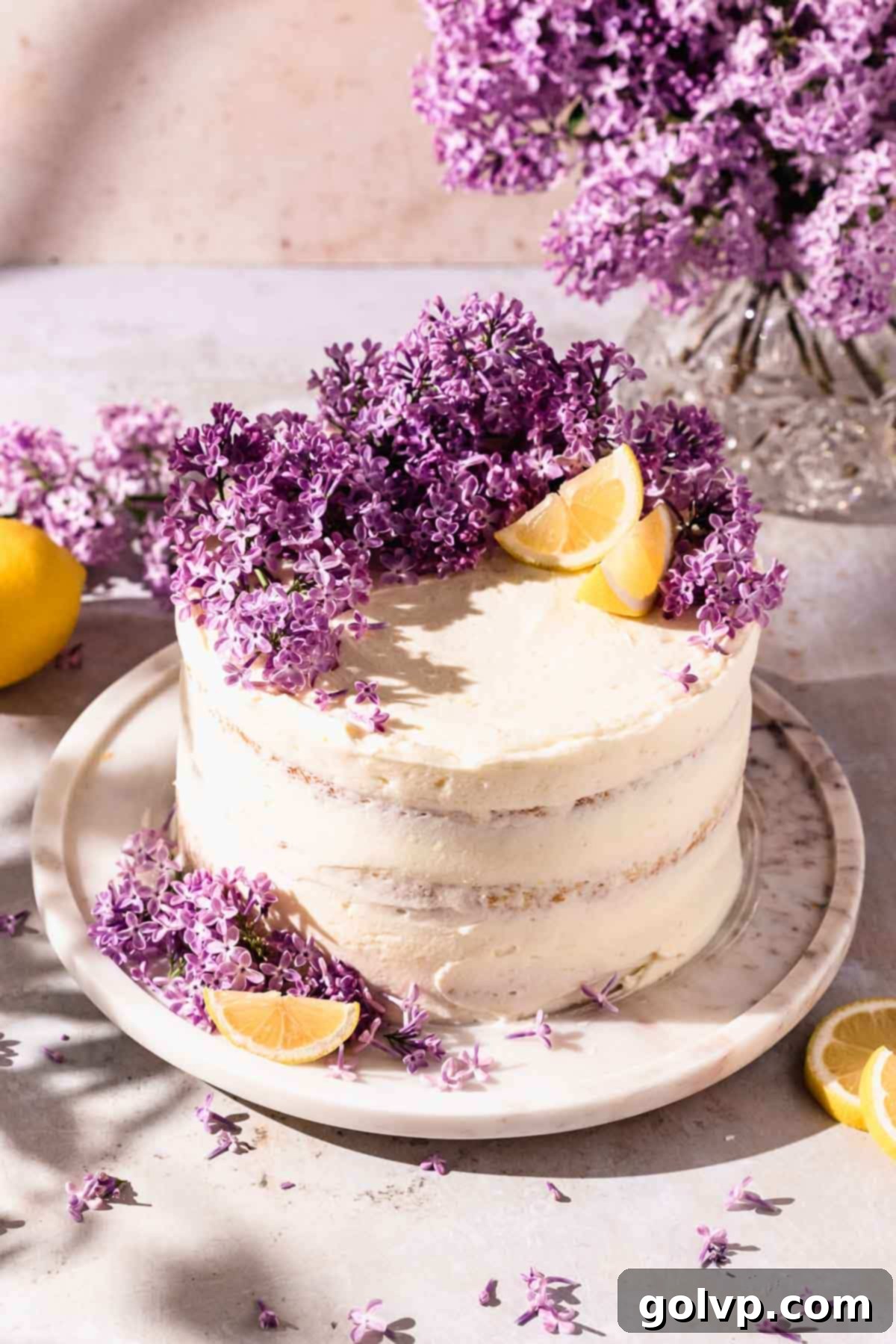Fragrant Lilac Lemon Cake with Zesty Cream Cheese Frosting: Your Perfect Spring & Summer Dessert
Embrace the vibrant flavors of spring and early summer with this exquisite Lilac Lemon Cake. It’s a dessert that captivates both the eye and the palate, featuring a truly unique blend of delicate floral notes and bright citrus zest. Imagine a cake that’s not just soft and moist, but also infused with the subtle perfume of fresh lilacs, complemented by the lively tang of lemon. This isn’t just a cake; it’s an experience, a celebration of seasonal beauty that will leave a lasting impression on anyone lucky enough to try a slice.
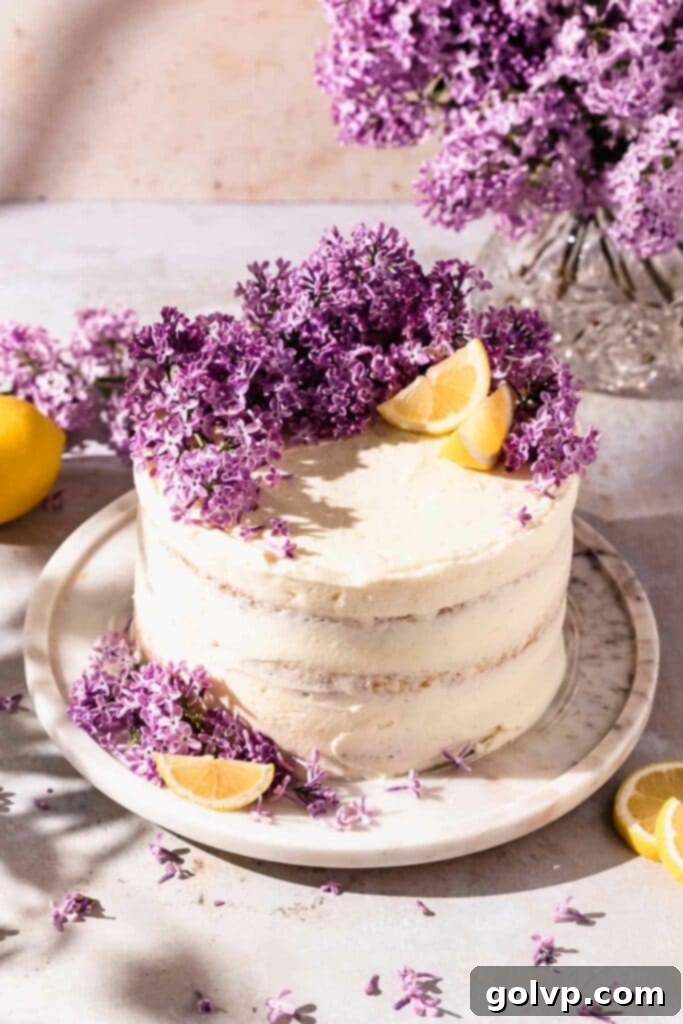
Please note: Purchasing items through the links in this post helps support this blog, at no additional cost to you. As an Affiliate Product marketer and Amazon Associate, I may earn a small commission from qualifying purchases.
Why You’ll Adore This Fragrant Lilac Lemon Cake Recipe:
- Unforgettable Lilac Flavor: This cake offers a light, ethereal floral flavor derived from real lilac flowers and syrup. Unlike many artificial floral essences, the taste here is delicate and natural, perfectly harmonizing with the lemon without overpowering it. It’s a true taste of spring and summer, elevating a classic lemon cake to something truly special.
- Perfectly Balanced Texture: Prepare for a baking revelation! Each layer of this cake is meticulously crafted to be incredibly soft, wonderfully moist, and delightfully fluffy. We’ve found the perfect ratio of ingredients and techniques to ensure your cake is never dry or dense, but always melts in your mouth with every bite.
- Irresistible Lemon Cream Cheese Frosting: What’s a fantastic cake without an equally amazing frosting? Our lemon cream cheese frosting is the ideal companion to the floral cake layers. It’s gloriously creamy, wonderfully tangy, and infused with just the right amount of lemon zest, providing a refreshing counterpoint to the sweetness of the cake. It’s light yet rich, making each spoonful an absolute delight.
- Seasonal Elegance: This recipe is designed to be made when lilacs are in peak bloom, making it a celebration of seasonal ingredients. Serving this beautiful cake is a fantastic way to impress guests and bring a unique, sophisticated touch to any spring gathering, Mother’s Day brunch, or early summer celebration.
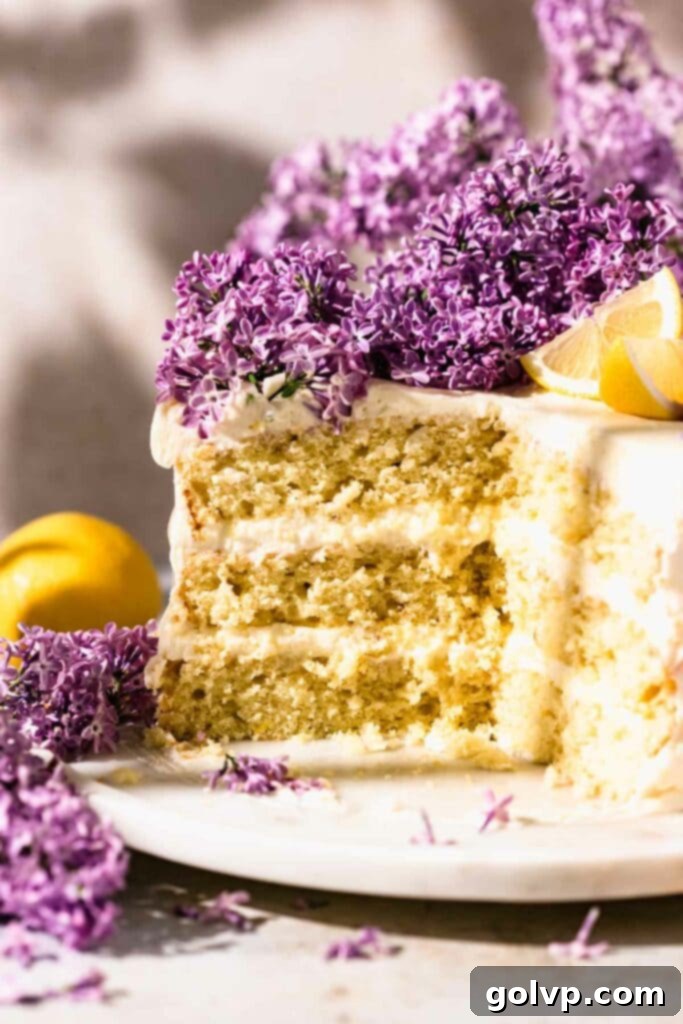
Unlocking the Delicate Lilac Flavor in Your Cake
Lilacs possess a remarkably subtle and delicate floral flavor, making them a unique ingredient in baking. To truly capture their essence in this stunning cake, we employ a two-pronged approach: incorporating fresh lilac petals directly into the cake batter and generously soaking the baked layers with homemade lilac syrup. This dual infusion ensures a nuanced and fragrant experience in every bite.
The secret to maximizing the lilac flavor within the cake layers lies in a simple yet effective technique: gently rubbing the fresh lilac petals with sugar and lemon zest. This process helps to break down the petals and release their aromatic oils, infusing the sugar with their delicate perfume. The lemon zest acts as a natural enhancer, brightening the floral notes. Don’t worry about noticeable petals in the final cake; they soften beautifully into the batter, leaving behind only their delightful flavor.
Lilac Foraging Tip: When you’re picking lilac flowers for your cake, be mindful to avoid including any green stems or darker green parts of the flower clusters. These can introduce a bitter taste that would detract from the cake’s delicate flavor profile. Stick to the vibrant, fragrant petals themselves for the best results.
Harvesting Edible Lilacs: A Guide for Home Bakers
Finding the right lilacs for baking is crucial for both flavor and safety. The most important rule is to source your lilacs from areas that are free from pesticides and herbicides. Avoid picking flowers from trees or bushes located right next to busy roadsides, as they may have absorbed pollutants. Instead, look for lilacs in your own garden, a friend’s garden (with permission!), or secluded natural areas.
Did you know that different colors of lilacs can offer slightly different flavor nuances? It’s true! Before you commit a large batch of flowers to your recipe, it’s a good idea to taste a few petals from your chosen plant. The pale purple lilacs I used for this recipe provided a wonderfully balanced and aromatic flavor that I absolutely loved. Experiment a little to find the variety that speaks to your taste buds!
What Do Lilacs Taste Like? Flavor Profile & Substitutes
The taste of lilacs is as enchanting as their scent: delicate, subtly sweet, and distinctly floral. Many describe it as tasting exactly how they smell. It’s not quite like the more intense, often camphor-like notes of lavender, nor the deep, sometimes musky sweetness of rose. Instead, the flavor of lilac is surprisingly akin to elderflower – light, bright, and incredibly refreshing. This makes lilac syrup a fantastic addition not only to cakes but also to spring cocktails, sparkling water, or homemade lemonade, where it imparts a beautiful, nuanced sweetness.
If fresh lilacs are not in season or simply unavailable where you live, don’t despair! You can still enjoy a wonderfully floral cake with a very similar flavor profile. Simply omit the lilac petals from the cake batter and instead, use high-quality elderflower syrup to brush over your baked cake layers. This easy substitution ensures you can enjoy a delicate floral cake any time of the year!
Crafting Homemade Lilac Syrup: Simple & Versatile
One of the true stars of this lilac cake is the homemade lilac syrup. It’s incredibly simple to prepare, requiring just three ingredients: sugar, water, and fresh lilac flowers. Essentially, you’re making a classic 1:1 simple syrup, but with the added magic of steeping fresh lilac petals. The result is a fragrant syrup that infuses the cake layers with a delicate floral flavor—much lighter and more nuanced than the often bolder tastes of lavender or rose. Its profile is remarkably similar to elderflower syrup, making it wonderfully versatile.
This recipe for lilac syrup makes enough for you to generously brush your cake layers and still have some leftover. Don’t let the extra go to waste! It’s fantastic for sweetening iced tea, lemonade, cocktails, or even drizzling over fruit salads and yogurt. Stored in an airtight container, your homemade lilac syrup will keep beautifully in the refrigerator for up to two weeks, allowing you to enjoy the essence of spring long after the blooms have faded.

Secrets to Achieving Perfectly Soft & Tender Cake Layers
The texture of this lilac cake is just as important as its flavor. We aim for layers that are melt-in-your-mouth soft and exquisitely tender. My personal preference in cakes lies in the rich flavor of butter combined with the incredible tenderness that vegetable oil provides. To get the best of both worlds – the luscious taste of butter and an ultra-tender crumb – this recipe smartly combines both fats. This method, similar to the one used in my popular blueberry birthday cake recipe, guarantees a superior texture.
Here are some crucial tips to ensure your cake layers turn out absolutely perfect:
- Room Temperature Ingredients are Key: This cannot be stressed enough! Ensure all your cold ingredients, such as butter, eggs, buttermilk, and sour cream, are at true room temperature. This allows them to emulsify properly with the other ingredients, creating a smooth, homogenous batter that bakes up evenly and with a delicate, tender texture.
- Weigh Your Flour: For the most accurate and consistent results in baking, using a kitchen scale to measure your flour is paramount. Volume measurements can vary significantly, leading to a cake that’s either too dry (if too much flour is added) or too dense. Precise flour measurement ensures the perfect moisture content and crumb for your lilac cake. If you don’t have a scale, gently spoon the flour into your measuring cup and level it off without packing it down.
- Do Not Overmix the Batter: Overmixing develops the gluten in the flour, resulting in a tough, chewy cake rather than a tender one. Once you’ve added the flour, mix only until just combined – as soon as no dry streaks of flour remain, stop mixing. A few small lumps are better than an overmixed batter.
- Proper Baking Time: Keep a close eye on your cake as it bakes. Remove the lilac cake layers from the oven when a toothpick inserted into the center comes out clean, with perhaps a few moist crumbs attached. If you see wet batter, it needs a bit more time. Overbaking will lead to dry cake layers, so trust the toothpick test!
Mastering the Zesty Lemon Cream Cheese Frosting
A truly spectacular cake deserves an equally spectacular frosting, and this Lemon Cream Cheese Frosting delivers. It’s the perfect balance of tangy, sweet, and creamy, providing a bright contrast to the subtle floral notes of the lilac cake. Achieving that perfectly smooth, fluffy, and stable cream cheese frosting requires a few key techniques.
The primary secret to a light and airy cream cheese frosting is thoroughly beating the butter and powdered sugar. Don’t rush this step! Beat them together for an extended period, significantly longer than you might think, until the mixture is visibly lightened in color and incredibly fluffy. This aeration is what gives the frosting its wonderful texture and ensures it doesn’t taste overly buttery.
For the cream cheese itself, I advocate for using lightly softened cream cheese. Instead of letting it sit out for hours, aim for about 10 minutes at room temperature. This gentle softening prevents the cream cheese from becoming too warm and “gloopy,” which can lead to a runny, unstable frosting. It should still be cool to the touch but pliable.
Troubleshooting Tip: If your frosting does unfortunately become too thin or appears gloopy, don’t panic! Place the entire bowl of frosting into the refrigerator for 10-20 minutes to chill and firm up. Once chilled, beat it again, and if necessary, gradually add a little more sifted powdered sugar until it reaches your desired thick, fluffy, and workable consistency. Patience is key when working with cream cheese frosting!
Essential Ingredients for Your Lilac Lemon Cake
Crafting this fragrant lilac lemon cake requires a few key ingredients, each playing an important role in achieving its unique flavor and perfect texture. Here’s a closer look at what you’ll need and why:
- Fresh Lilacs: The star of the show! As discussed, these delicate flowers can be foraged from bushes and trees. Remember to avoid any that may have been sprayed with chemicals or are too close to busy roads. Always pick just the petals, leaving out any bitter green stems, for the purest lilac flavor.
- Lemons: You’ll need fresh lemons for both the zest and the juice. The zest carries potent oils that infuse the cake and frosting with bright, aromatic lemon flavor, while the juice adds a crucial tangy counterpoint. Always zest your lemons before juicing them – it’s much easier!
- Butter: For the best results, opt for good quality, unsalted real butter. It provides rich flavor and contributes to the cake’s tender crumb. Ensure it’s softened to room temperature for optimal creaming.
- Vegetable Oil: A neutral-tasting oil, such as grapeseed oil (my personal favorite), canola, or sunflower oil, is essential. It contributes to the cake’s incredible moisture and softness, giving it that desirable melt-in-your-mouth texture.
- Buttermilk: For truly tender cake layers, I highly recommend using store-bought buttermilk or kefir. While DIY versions exist, commercially prepared buttermilk provides a consistent acidity that reacts beautifully with the baking soda and powder, resulting in a lighter, more tender crumb. Make sure it’s at room temperature.
- All-Purpose Flour: Accuracy in measuring flour is paramount for cake success. Weighing your flour (400g for this recipe) with a kitchen scale is the most precise method. If you’re measuring by volume, first stir the flour in its bag to aerate it, then gently spoon it into your measuring cup until overflowing, and finally, level off the excess with the flat edge of a knife without packing it down.
- Cream Cheese: For the creamiest, most stable frosting, full-fat, brick-style cream cheese is a must. Brands like Philadelphia work exceptionally well. Avoid low-fat or whipped cream cheese varieties, as they contain too much water and can make your frosting runny and difficult to work with. Allow it to soften slightly, about 10 minutes at room temperature, before using.
- Powdered Sugar (Icing Sugar): This fine sugar gives the frosting its smooth texture and sweetness. If your powdered sugar seems lumpy, a quick sift before adding it to the butter mixture will ensure a silky-smooth frosting.
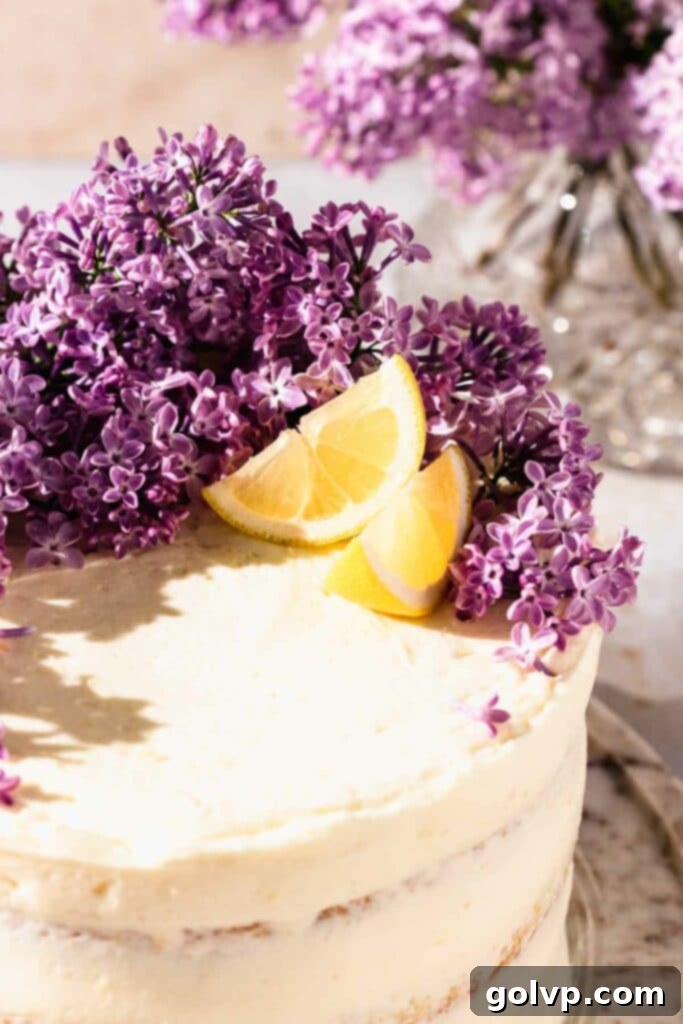
How to Make Lilac Syrup from Scratch
Making your own fragrant lilac syrup is incredibly easy and essential for this cake’s delicate floral notes. Follow these simple steps:
- Step 1: Combine Ingredients. In a medium saucepan, combine 1 cup granulated sugar, 1 cup water, and 2 cups of packed lilac flowers (ensure no green stems are included).
- Step 2: Simmer and Steep. Heat the mixture over medium-high heat, stirring frequently to dissolve the sugar and prevent it from burning. Once it comes to a boil, reduce the heat and let it simmer gently for about ten minutes. This allows the lilac essence to fully infuse the syrup. Turn off the heat and allow the syrup to cool completely to room temperature right inside the saucepan, letting the lilacs steep even longer.
- Step 3: Strain and Store. Once cooled, pour the syrup through a fine-mesh sieve to strain out all the lilac petals. Transfer the beautiful, subtly colored syrup to an airtight container or jar. It can be stored in the refrigerator for up to two weeks.
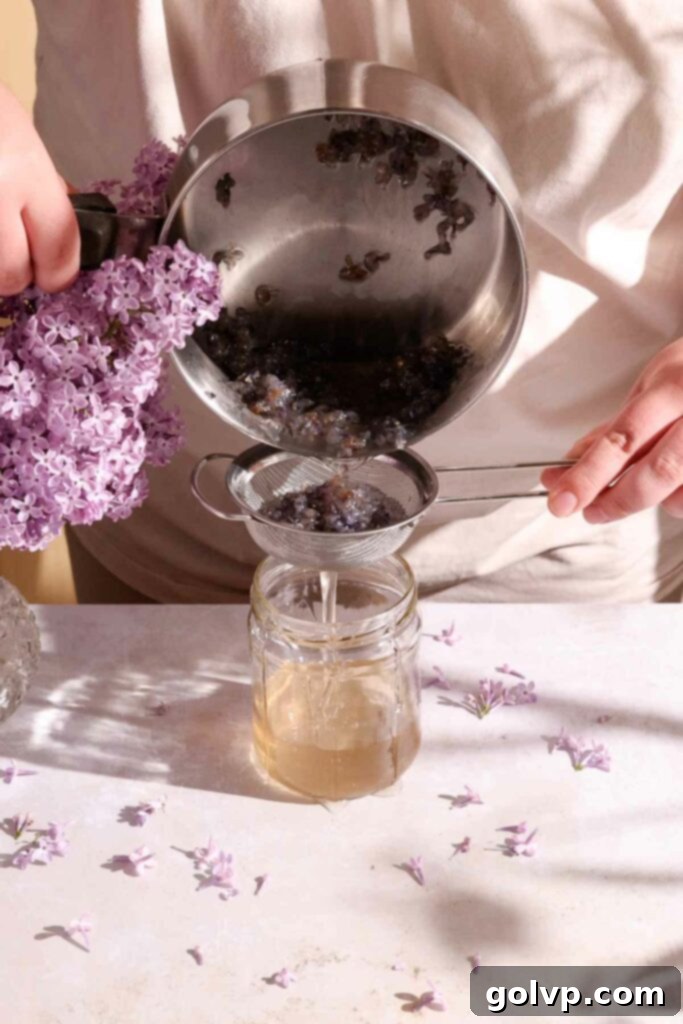
Step by Step: Baking the Lilac Lemon Cake Layers
Let’s get baking! These steps will guide you to creating perfectly moist and flavorful lilac lemon cake layers.
- Step 1: Prepare Pans & Preheat Oven. Using a cold piece of butter, thoroughly grease and line the bottoms of three 8-inch round baking pans with parchment paper. This prevents sticking and ensures easy release. Preheat your oven to 350°F (180°C).
- Step 2: Infuse Sugar with Lilac & Lemon. In a large mixing bowl or the bowl of a stand mixer, combine 1 ¼ cups sugar, ⅛ teaspoon sea salt, the zest of 1 lemon, and ¾ cup of packed lilac flowers (again, no green stems). Using your fingertips, rub this mixture together vigorously until it becomes wonderfully fragrant and the sugar is infused with the aromas.
- Step 3: Cream Fats with Aromatic Sugar. Add ¾ cup softened butter and ¼ cup vegetable oil to the bowl with the sugar mixture. Beat on medium speed until the mixture is light, fluffy, and noticeably lightened in color. Remember to scrape down the sides and bottom of the bowl frequently to ensure even mixing.
- Step 4: Incorporate Eggs. Add 4 large room temperature eggs one at a time, beating well after each addition until fully incorporated. Scrape down the bowl frequently to ensure everything is well combined.
- Step 5: Add Wet Ingredients. Mix in ½ cup room temperature sour cream and 3 tablespoons fresh lemon juice. Beat until just combined. Don’t be alarmed if the batter appears to split or look slightly grainy at this stage; this is perfectly normal and will come together with the dry ingredients.
- Step 6: First Flour Addition. Directly into the same bowl, sift in half of your 3 ⅓ cups all-purpose flour, along with ½ teaspoon baking soda and 1 tablespoon baking powder. Gently fold these dry ingredients into the wet mixture until they are mostly incorporated, but still show a few streaks.
- Step 7: Final Flour Addition. Add ¾ cup room temperature buttermilk, then sift the remaining half of the flour into the bowl. Continue to fold gently until no more dry streaks of flour remain. Be careful not to overmix!
- Step 8: Bake. Divide the cake batter evenly among the three prepared cake pans and gently smooth the tops with an offset spatula. Bake for 20-25 minutes, or until a toothpick inserted into the center of a cake layer comes out mostly clean with a few moist crumbs attached.
- Step 9: Cool Cake Layers. Let the cake layers cool in their pans for 10 minutes before carefully running a knife around the edges to help release them. Invert them onto a wire cooling rack and allow them to cool completely before frosting. This step is crucial for preventing the frosting from melting.
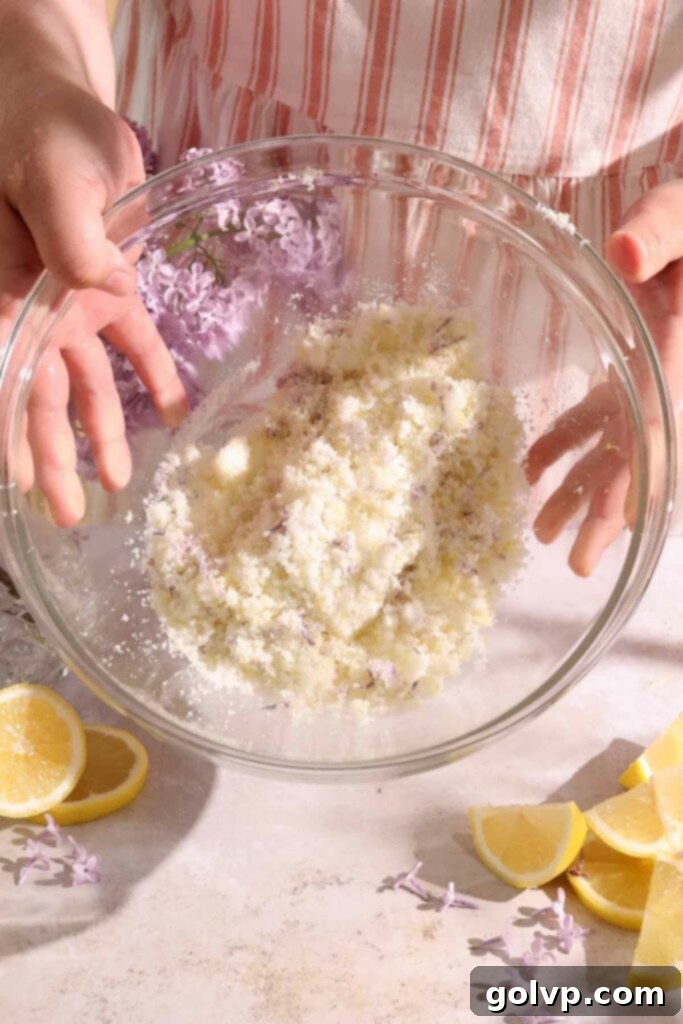
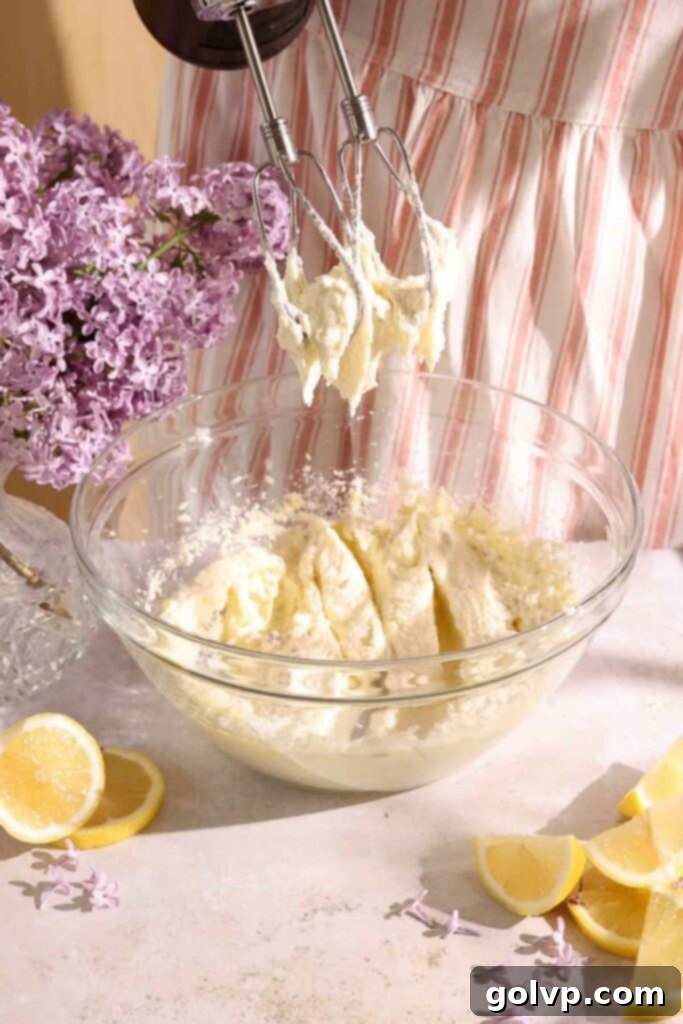
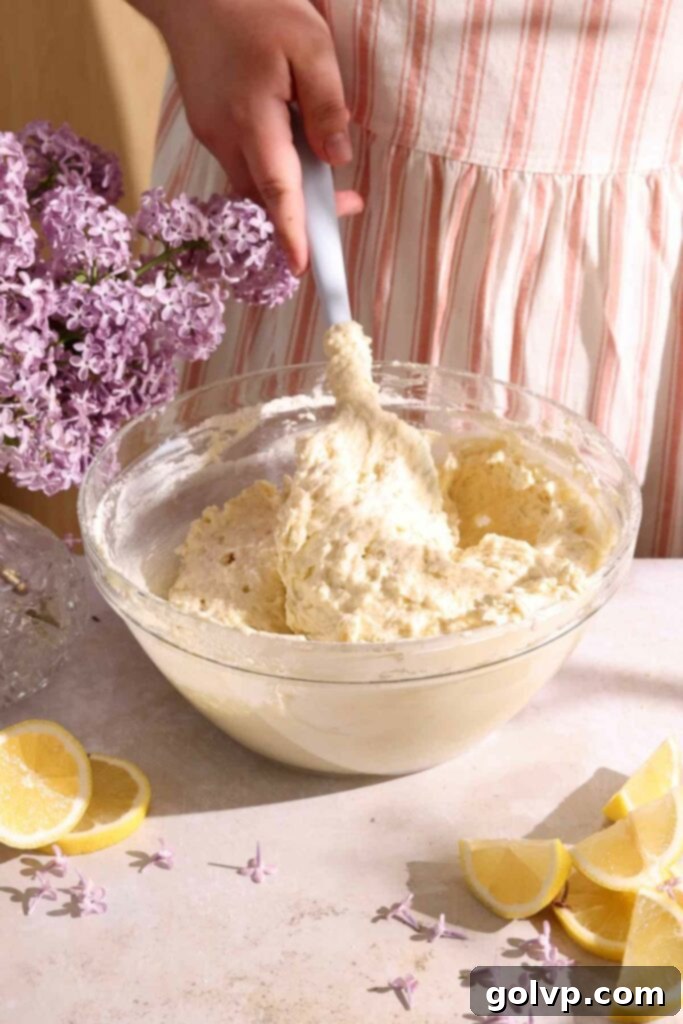
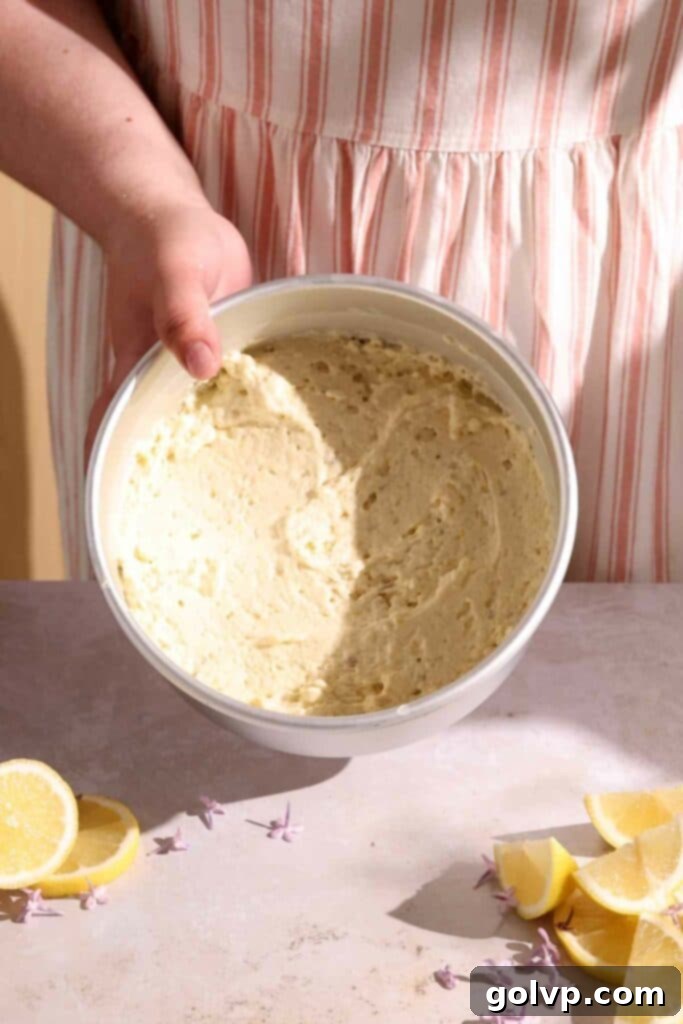
Step by Step: Preparing the Lemon Cream Cheese Frosting
This luscious lemon cream cheese frosting is the perfect complement to our delicate lilac cake. Follow these steps for a smooth, tangy, and fluffy frosting.
- Step 1: Cream Butter & Powdered Sugar. In a large bowl or the bowl of a stand mixer fitted with the paddle attachment, beat 2 cups unsalted butter until it’s light and creamy. Gradually add 8 cups of sifted powdered sugar, one cup at a time, beating on medium-high speed. Continue to beat for a full 7-10 minutes until the mixture is incredibly light, airy, and significantly creamier. Frequent scraping of the bowl is essential during this stage.
- Step 2: Incorporate Cream Cheese. Add 8 oz lightly softened cream cheese (softened for just 10 minutes at room temperature) into the butter and sugar mixture, piece by piece. Beat well after each addition until fully incorporated. Again, scrape down the bowl frequently to ensure a smooth, lump-free consistency.
- Step 3: Add Lemon & Adjust Consistency. Stir in the zest of 1 lemon and beat again until well combined. Now, add freshly squeezed lemon juice, a tablespoon at a time, as needed to achieve your desired workable, thick, and fluffy frosting texture. Be careful not to add too much, as this can make the frosting too thin. Stop mixing as soon as the desired consistency is reached.
Assembling Your Beautiful Lilac Lemon Cake
Now for the exciting part – bringing all the components together to create your show-stopping lilac lemon cake!
- Step 1: Prepare First Layer. Carefully peel the parchment paper off your cooled cake layers. Place a small dollop of lemon cream cheese frosting onto your chosen cake stand or serving plate. This acts as an anchor to prevent the cake from sliding. Place the first cake layer on top, right side up. Using a spoon or a pastry brush, liberally douse this cake layer with your homemade lilac syrup.
- Step 2: Stack & Syrup the Second Layer. Add a generous scoop of the lemon cream cheese frosting over the first syrup-soaked layer and spread it out evenly to the edges. Gently place the second cake layer on top, this time upside down (this creates a flatter top for the next layer). Brush this layer liberally with more lilac syrup, then add another generous scoop of frosting and spread it out evenly.
- Step 3: Add Final Layer & Crumb Coat. Place the last cake layer on top, also upside down. Brush it liberally with the remaining lilac syrup. Now, apply a thin, even layer of frosting all over the outside of the entire cake. This is called a “crumb coat” and helps to seal in any loose crumbs. Freeze the cake for about 10-15 minutes to allow this crumb coat to firm up. You can stop here for a trendy “semi-naked” cake look, or proceed to the next step for a fully frosted cake.
- Step 4: Final Frosting. Once the crumb coat is firm, apply the rest of your lemon cream cheese frosting to the cake. Use a long metal offset spatula and/or a cake scraper to smooth it down for a polished finish. Take your time with this step – practice makes perfect! Feel free to add any decorative design you prefer.
- Step 5: Decorate & Serve. Decorate the top of your exquisite lilac lemon cake with fresh lilac flower clusters and vibrant lemon wedges for a stunning visual appeal. Serve the cake at room temperature for the best flavor and texture. Enjoy this beautiful and fragrant dessert!
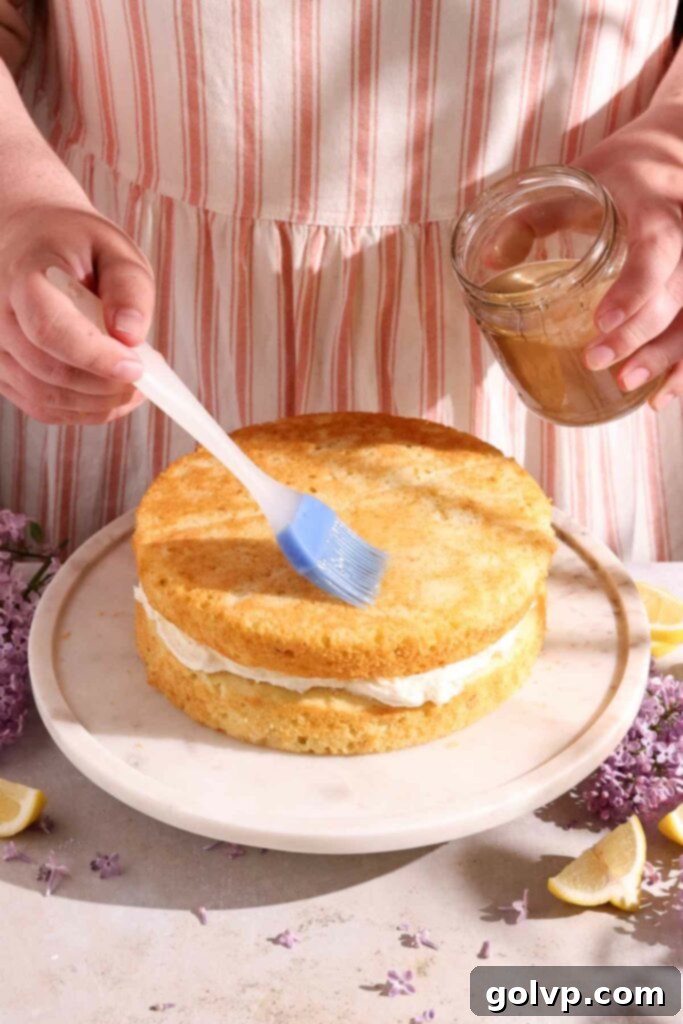
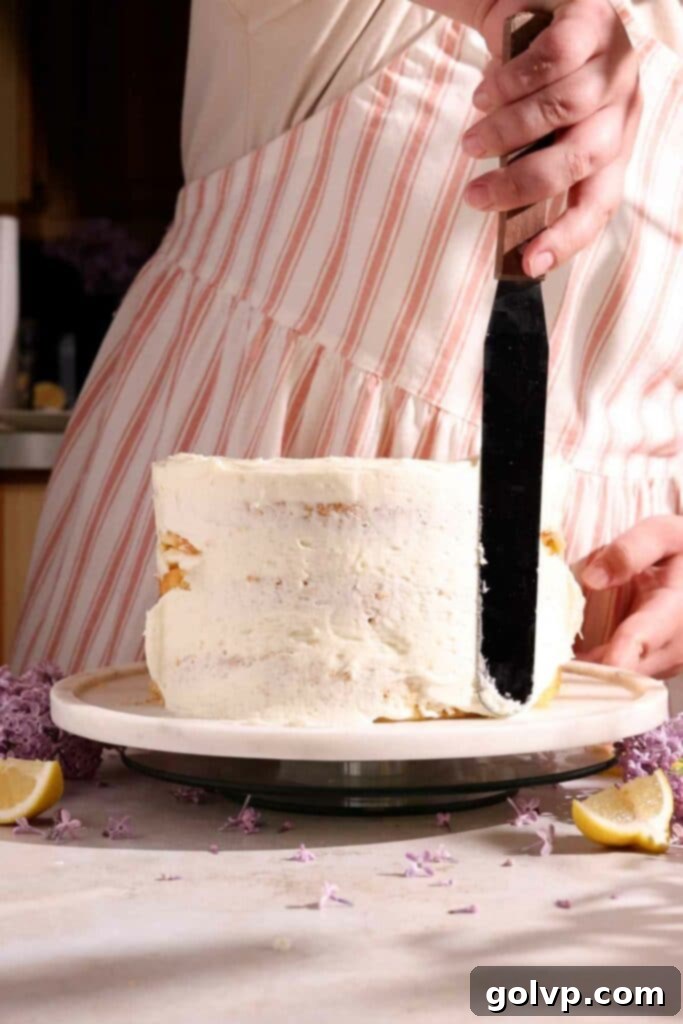
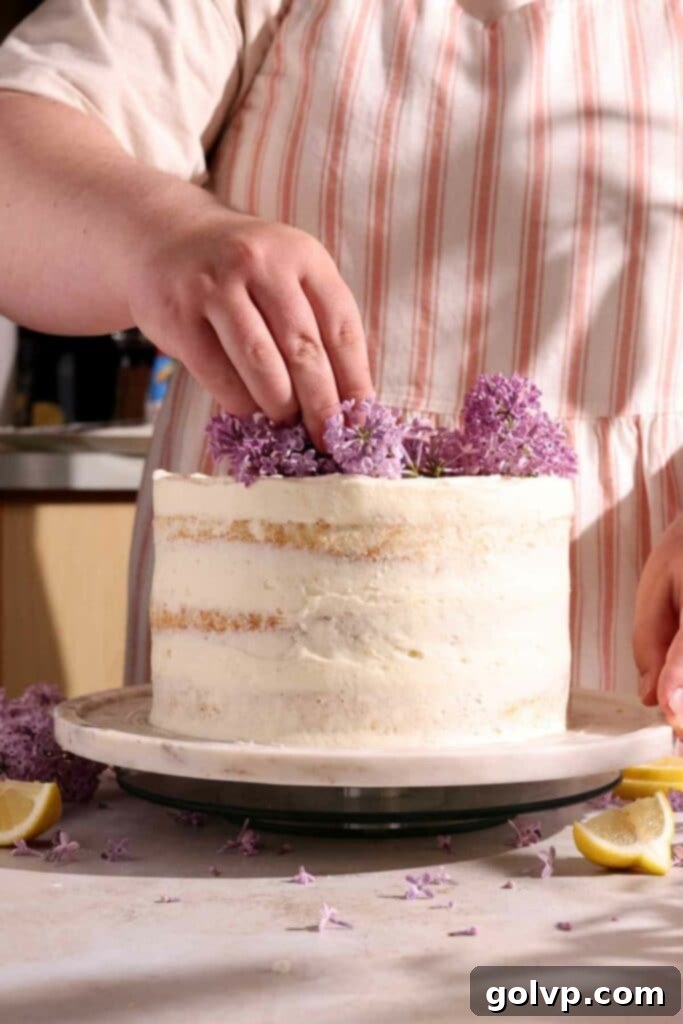
Frequently Asked Questions (FAQ) about Lilac Lemon Cake
Leftover lilac syrup is a versatile delight! You can use it to sweeten a variety of drinks – try adding it to iced tea, sparkling water, or even homemade lemonade for a beautiful peachy hue and delicate floral flavor. It’s also lovely drizzled over fresh fruit, yogurt, or ice cream.
When stored in an airtight container in the refrigerator, your homemade lilac syrup will keep well for up to two weeks, allowing you to enjoy its unique flavor beyond lilac season.
If fresh lilacs are out of season or hard to find, you can still enjoy a delicious floral cake! Simply omit the fresh lilacs from the cake batter. For the syrup, substitute the homemade lilac syrup with store-bought elderflower syrup. Elderflower has a very similar delicate floral flavor profile to lilac, making it an excellent year-round substitute.
If your cake layers are sliding, the frosting is likely too warm and soft, or the cake itself hasn’t fully cooled. To remedy this, pop the cake (and the frosting bowl if needed) into the freezer for 10-20 minutes to firm everything up. You can also briefly chill the frosting to thicken it. For extra stability, especially with taller cakes, consider inserting a few wooden dowels or skewers into the center of the cake before applying the final frosting layers.
More Delightful Baking Recipes to Try:
- Lemon Victoria Sponge with Lemon Curd
- Strawberry Butter Cake
- Blueberry Cinnamon Rolls
- Lemon Curd Cookies
Happy baking, and enjoy the delightful flavors of spring!
Did you make this fragrant Lilac Lemon Cake? I would absolutely love for you to rate this recipe and share your thoughts in the comments below! Don’t forget to share your beautiful creation on Instagram and tag @flouringkitchen. Follow me on Pinterest for more inspiring recipe ideas and baking tips.
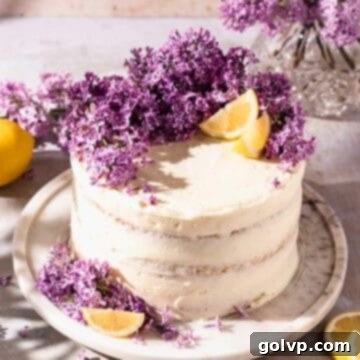
Lilac Lemon Layer Cake with Cream Cheese Frosting
Mary
Pin Recipe
Shop Ingredients
Equipment
-
3 eight inch round baking pans
Ingredients
Lilac Syrup
- 1 cup granulated sugar
- 1 cup water
- 2 cups fresh lilac flowers packed (without any green stems)
Cake Layers
- 1 ¼ cup granulated sugar
- ⅛ teaspoon sea salt
- 1 lemon zested
- ¾ cup fresh lilac flowers packed (without any green stems)
- ¾ cup unsalted butter softened, room temperature
- ¼ cup neutral vegetable oil
- 4 large eggs room temperature
- ½ cup sour cream room temperature
- 3 tablespoons fresh lemon juice
- 3 ⅓ cup all purpose flour (400g)
- ½ teaspoon baking soda
- 1 tablespoon baking powder
- ¾ cup buttermilk room temperature
Lemon Cream Cheese Frosting
- 2 cups unsalted butter softened, room temperature
- 8 cups powdered sugar
- 8 oz cream cheese full-fat, brick style, softened for 10 minutes at room temperature
- 1 lemon zested
- Fresh lemon juice freshly squeezed, as needed
Assembly & Decoration
- Fresh Lilac flower clusters
- Lemon wedges for garnish
Shop Ingredients on Jupiter
Instructions
For the Lilac Syrup
-
In a medium saucepan, combine 1 cup granulated sugar, 1 cup water, and 2 cups packed lilac flowers. Heat on medium-high, stirring to dissolve sugar.
-
Bring to a boil, then simmer for ten minutes. Turn off heat and let cool to room temperature in the saucepan.
-
Strain out petals through a sieve. Transfer syrup to an airtight container and refrigerate for up to two weeks.
For the Cake Layers
-
Grease and line the bottoms of three 8” round pans. Preheat oven to 350°F (180°C).
-
In a large bowl, combine 1 ¼ cup sugar, ⅛ teaspoon sea salt, 1 lemon zested, and ¾ cup lilac flowers. Rub together until fragrant.
-
Add ¾ cup softened butter and ¼ cup vegetable oil. Beat until creamed and light in color, scraping the bowl frequently.
-
Add 4 large eggs one by one, beating well after each and scraping the bowl.
-
Add ½ cup sour cream and 3 tablespoons lemon juice. Beat until combined (batter may look grainy, which is fine).
-
Sift in half of the 3 ⅓ cup all-purpose flour, ½ teaspoon baking soda, and 1 tablespoon baking powder. Fold until mostly incorporated.
-
Add ¾ cup buttermilk and sift the rest of the flour. Fold until no streaks remain (do not overmix).
-
Divide batter evenly into pans. Bake for 20-25 minutes, or until a toothpick comes out mostly clean. Cool in pans for 10 minutes, then invert onto a rack to cool completely.
For the Lemon Cream Cheese Frosting
-
In a large bowl, beat 2 cups unsalted butter until light and creamy. Gradually add 8 cups powdered sugar, beating for 7-10 minutes until very light and creamy. Scrape bowl frequently.
-
Add 8 oz cream cheese piece by piece, beating well after each addition and scraping the bowl frequently.
-
Add 1 lemon zested and beat again. Add fresh lemon juice as needed to reach a thick, fluffy, workable consistency.
Assembly
-
Peel parchment from cake layers. Place a dollop of frosting on a stand, then the first cake layer right side up. Liberally brush with lilac syrup.
-
Add a generous scoop of frosting, spread evenly. Place the next cake layer upside down. Brush with syrup, add more frosting, and spread.
-
Add the last layer upside down. Brush with syrup. Cover the cake with a thin crumb coat of frosting. Freeze for 10 minutes to harden.
-
Cover the cake with the remaining frosting, smoothing with a spatula/scraper. Add any preferred design.
-
Decorate the top with fresh lilac clusters and lemon wedges. Serve at room temperature.
Video
Notes
The cake will keep well in the fridge for up to 3 days. Store it in a cake carrier to protect it and keep it fresh. To freeze the cake, pop the cake in the freezer for a few hours to firm up the frosting. Wrap it up tightly and freeze for up to 2 months. You can also freeze individual slices.
Make sure to let the cake sit at room temperature for 15-20 minutes if refrigerated before serving. This will help the butter in the frosting and cake layers soften, ensuring the best flavor and cake experience.
Flavour Tip: Due to the subtle nature of lilacs, this cake offers a delicate lilac flavor. For an even more pronounced floral experience, serve individual slices with an extra drizzle of lilac syrup and a sprinkle of fresh lilac flowers.
If you can’t find fresh lilacs, omit them from the cake batter and substitute the homemade lilac syrup with store-bought elderflower syrup. They share a very similar flavor profile and will still provide a wonderful floral essence.
